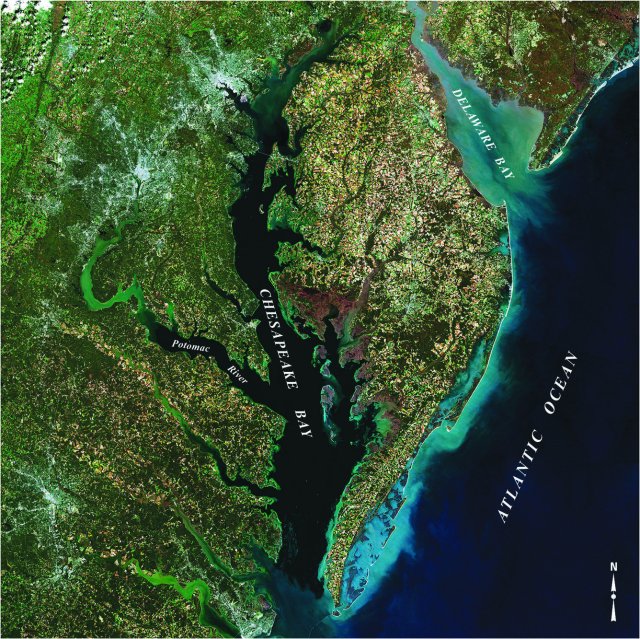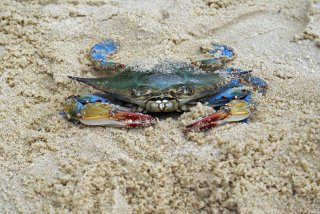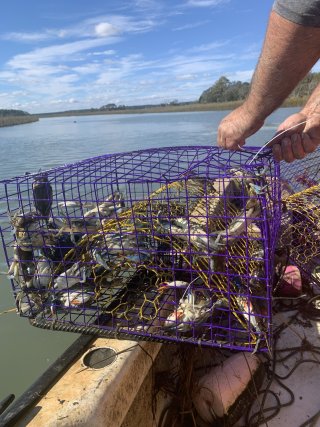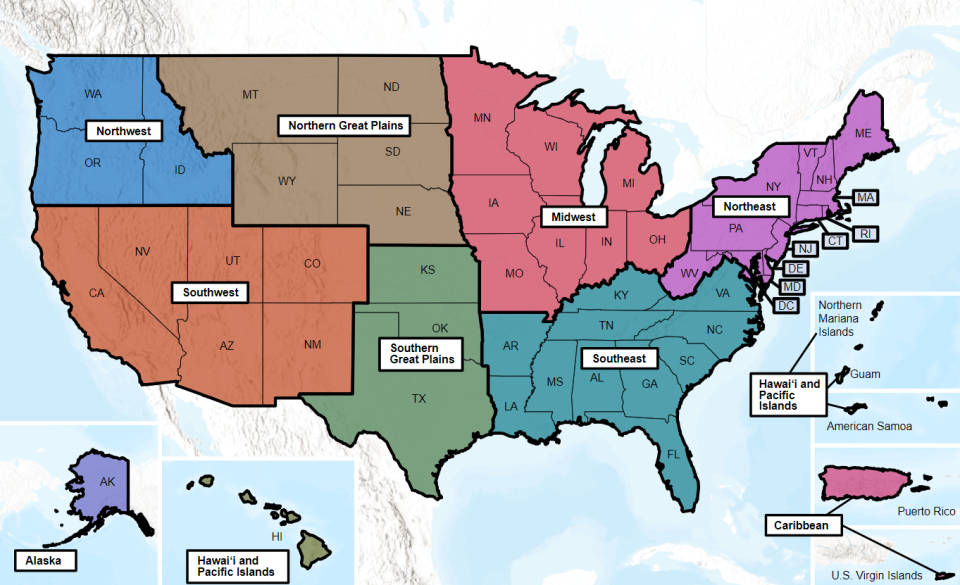Climate Change Connections: Maryland (Blue Crab)
Climate change is impacting all regions and sectors of the United States. The State and Regional Climate Change Connections resource highlights climate change connections to culturally, ecologically, or economically important features of each state and territory. The content on this page provides an illustrative example. As climate change will affect each state and territory in diverse ways, this resource only describes a small portion of these risks. For more comprehensive information about regional climate impacts, please visit the Fifth National Climate Assessment and Climate Change Impacts by Sector.
On this page:
Introduction: Crabs Hold Cultural, Ecological, and Economic Importance in the Chesapeake Bay

Blue crabs (Callinectes sapidus) are one of the most iconic species in Maryland and the Chesapeake Bay region. These crabs hold great cultural significance and are often enjoyed in cuisine during the summer holidays and at family gatherings.1 Blue crabs can be eaten whole (both hard or soft varieties) or as part of dips or crab cakes, and are a staple both in restaurants and in home cooking. Recreational crabbing is also a widespread summertime tradition throughout the Chesapeake Bay region. The annual National Hard Crab Derby and Fair is held every Labor Day weekend in Crisfield, Maryland, and hosts crab races, picking and cooking contests, and a traditional crab feast.2
Blue crabs are Maryland’s most valuable commercial fishery.3 The value of blue crab landings in Maryland is worth tens of millions of dollars each year.2 This crab industry supports many jobs across multiple sectors, including fishing, seafood processing, food service, and tourism. Blue crabs also play an important role in the Chesapeake Bay ecosystem as both prey and predator. Many animals feed on blue crabs at different stages of the crabs’ life cycle. Adult crabs are generalist predators and scavengers that eat a variety of crustaceans, small fishes, and plant material.4
Climate Impacts: Warming Temperatures and Blue Crabs
Chesapeake Bay water temperatures have been increasing in recent decades and are expected to continue to warm with climate change.5 These warmer waters are expected to affect blue crabs in a variety of ways. While blue crabs grow more quickly in warmer water, this increase in growth also means their feeding patterns and habitat shift.6 Warmer water temperatures are also associated with a decrease in the strength and thickness of the shells of blue crabs, which reduces the shells’ protective ability.7,8

Warming winter temperatures could increase the blue crab population. During winter, when water temperatures fall below about 50°F, blue crabs in the Chesapeake Bay usually enter a period of dormancy known as overwintering.9 Every year, a certain portion of the population does not survive the winter. However, with warming temperatures, this overwintering period in the Chesapeake Bay is projected to shorten by up to 50 percent by 2100.9,10 A shorter overwintering season could increase blue crab winter survival by at least 20 percent compared with current conditions.10 This means that under future warmer conditions, blue crabs could grow more quickly and for longer periods, while also being more likely to survive winter. However, this change may not necessarily lead to more blue crabs overall, as other climate-related effects on the crabs’ molts and the density of their shells could make them more vulnerable to predators, diseases, and other hazards.8,10
Ocean Acidification and Warming Temperatures Affecting Chesapeake Bay Ecosystems

While blue crabs could benefit from some climate change impacts, their habitat and prey are more vulnerable. Sea level rise threatens the sea grass and salt marshes that provide critical habitat and resources for juvenile blue crabs in the Chesapeake Bay.11 Coastal development and hardened structures, such as seawalls, limit the ability of wetlands to shift, which can reduce available habitat.12 In the Chesapeake Bay, some key prey for blue crabs, including certain species of bivalve mollusks, are already near the limit of their range.13 Warming ocean waters could push key prey further north or out of the Bay entirely. Marine heat waves in the Chesapeake Bay are expected to increase in frequency and intensity the 21st century, contributing to decreased dissolved oxygen, which can harm a variety of fish and shellfish species.14
Increasing concentrations of carbon dioxide in the atmosphere means more carbon dioxide is being absorbed into the ocean. Carbon dioxide reacts with seawater to form carbonic acid.15 The resulting increase in acidity (measured by lower pH values) changes the balance of minerals in the water. This makes it more difficult for some ocean creatures to produce a mineral called calcium carbonate, which is the main ingredient in their hard skeletons or shells. Various shell-building animals that blue crabs prey on, like oysters and clams, have also displayed slower growth rates and weaker shells as ocean water becomes more acidic due to greenhouse gas emissions.16
Taking Action: Adapting Marine Management in a Changing Climate
Addressing climate change requires reducing greenhouse gas emissions while preparing for and protecting against current and future climate impacts. Communities, public officials, and individuals in every part of the United States can continue to explore and implement climate adaptation and mitigation measures. In Maryland, many organizations are taking steps to monitor and protect blue crab populations, including:
- Monitoring. As the blue crab is such an economically and environmentally important species in the Chesapeake Bay, populations are carefully monitored and tracked every year.4 The State of Maryland works together with the Commonwealth of Virginia and the Potomac River Fisheries Commission to manage and maintain a sustainable blue crab population based on the best available science. Continuing to monitor changing environmental conditions and blue crab stocks are important adaptation strategies to ensure a sustainable crab fishery and Chesapeake Bay ecosystem for future generations.
- Adjusting harvest windows. Currently, crabbing is prohibited during the overwintering period (December to March) in the Chesapeake Bay. This restriction helps maintain the Chesapeake Bay blue crab population at sustainable levels, as blue crabs become less active and populations naturally decrease during the winter. Even as warmer temperatures may provide blue crabs with longer periods of activity, strategic management and restrictions will remain important to protect crabs during vulnerable periods of development.10
To learn more about climate change impacts in Maryland and the Northeast region, see Chapter 21 of the Fifth National Climate Assessment.
Related Resources
- EPA Climate Change Indicators: Ocean Acidity
- EPA Climate Change Indicators: Sea Surface Temperature
- EPA Climate Change Indicators: Marine Heat Waves
- Maryland State Climate Summary 2022 (NOAA)
- Climate Change Program (Maryland Department of the Environment)
- Chesapeake Bay: Climate Change (NOAA)
References
1 Paolisso, M. (2007). Taste the traditions: Crabs, crab cakes, and the Chesapeake Bay blue crab fishery. American Anthropologist, 109(4), 654–665. https://doi.org/10.1525/aa.2007.109.4.654
2 Maryland State Archives. (2022). Maryland state crustacean – Blue crab. Maryland Manual On-Line. Retrieved August 4, 2023, from https://msa.maryland.gov/msa/mdmanual/01glance/html/symbols/crab.html
3 NOAA Fisheries. (2023). Landings (3.16.0.7) [Data set]. Retrieved November 29, 2023, from https://www.fisheries.noaa.gov/foss/f?p=215:200:15239389896888:::::
4 NOAA Fisheries. (2023). Blue crab. Species Directory. https://www.fisheries.noaa.gov/species/blue-crab
5 Ding, H., & Elmore, A. (2015). Spatio-temporal patterns in water surface temperature from Landsat time series data in the Chesapeake Bay, U.S.A. Remote Sensing of Environment, 168, 335–348. https://doi.org/10.1016/j.rse.2015.07.009
6 Rogers, T. L., Gouhier, T. C., & Kimbro, D. L. (2022). Distinct temperature stressors acting on multiple ontogenetic stages influence the biogeography of Atlantic blue crabs. Marine Ecology Progress Series, 690, 97–111. https://doi.org/10.3354/meps14039
7 Glandon, H. L., Kilbourne, K. H., Schijf, J., & Miller, T. J. (2018). Counteractive effects of increased temperature and pCO2 on the thickness and chemistry of the carapace of juvenile blue crab, Callinectes sapidus, from the Patuxent River, Chesapeake Bay. Journal of Experimental Marine Biology and Ecology, 498, 39–45. https://doi.org/10.1016/j.jembe.2017.11.005
8 Cunningham, S. R., & Darnell, M. Z. (2015). Temperature-dependent growth and molting in early juvenile blue crabs Callinectes sapidus. Journal of Shellfish Research, 34(2), 505–510. https://doi.org/10.2983/035.034.0246
9 Molina, A. I., Cerrato, R. M., & Nye, J. A. (2021). Population level differences in overwintering survivorship of blue crabs (Callinectes sapidus): A caution on extrapolating climate sensitivities along latitudinal gradients. PLOS ONE, 16(9), e0257569. https://doi.org/10.1371/journal.pone.0257569
10 Glandon, H. L., Kilbourne, K. H., & Miller, T. J. (2019). Winter is (not) coming: Warming temperatures will affect the overwinter behavior and survival of blue crab. PLOS ONE, 14(7), e0219555. https://doi.org/10.1371/journal.pone.0219555
11 NOAA Fisheries. (n.d.). Chesapeake Bay: Climate change. Retrieved August 6, 2024, from https://www.fisheries.noaa.gov/topic/chesapeake-bay/climate-change
12 NOAA Fisheries. (2019). The coastal squeeze: Changing tactics for dealing with climate change (New England/Mid-Atlantic). News. Retrieved December 1, 2023, from https://www.fisheries.noaa.gov/feature-story/coastal-squeeze-changing-tactics-dealing-climate-change
13 Hines, A. H., Johnson, E. G., Darnell, M. Z., Rittschof, D., Miller, T. J., Bauer, L. J., Rodgers, P., & Aguilar, R. (2010). Predicting effects of climate change on blue crabs in Chesapeake Bay. In G. H. Kruse, G. L. Eckert, R. J. Foy, R. N. Lipcius, B. Sainte-Marie, D. L. Stram, & D. Woodby (Eds.), Biology and management of exploited crab populations under climate change. Alaska Sea Grant College Program, University of Alaska Fairbanks. https://www.researchgate.net/publication/258236264_Predicting_Effects_of_Climate_Change_on_Blue_Crabs_in_Chesapeake_Bay
14 Whitehead, J. C., Mecray, E. L., Lane, E. D., Kerr, L., Finucane, M. L., Reidmiller, D. R., Bove, M. C., Montalto, F. A., O’Rourke, S., Zarrilli, D. A., Chigbu, P., Thornbrugh, C. C., Curchitser, E. N., Hunter, J. G., & Law, K. (2023). Ch. 21. Northeast. In A. R. Crimmins, C. W. Avery, D. R. Easterling, K. E. Kunkel, B. C. Stewart, & T. K. Maycock (Eds.), Fifth National Climate Assessment. U.S. Global Change Research Program. https://doi.org/10.7930/NCA5.2023.CH21
15 NOAA. (2020). Ocean acidification. Retrieved October 29, 2023, from https://www.noaa.gov/education/resource-collections/ocean-coasts/ocean-acidification
16 Glandon, H. L., & Miller, T. J. (2017). No effect of high pCO2 on juvenile blue crab, Callinectes sapidus, growth and consumption despite positive responses to concurrent warming. ICES Journal of Marine Science, 74(4), 1201–1209. https://doi.org/10.1093/icesjms/fsw171

